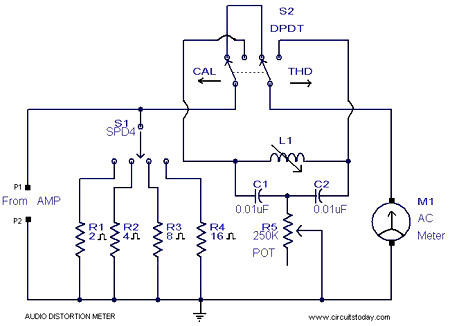Audio Distortion Meter
An audio distortion meter is used to measure distortions in, yes you guessed it right, audio. At certain frequencies the sound from most audio devices distorts, they become unclear. Of course, the frequencies and the level of distortions vary from device to device. A distortion meter helps to find the level of distortions as well as the frequencies at which the output audio goes under such a condition.
The aim of our project is to create a simple audio distortion meter. Definitely, you can buy readymade equipment for this from shops but that’s not why you are here; are you?
Description
Here is a simple 1KHz audio distortion meter that can measure the Total Harmonic Distortion (THD) on any load at any output power. Here you have the option to select 2,4,8 or 16 Ohm loads. The circuit works by filtering the 1 kHz fundamental signal using a notch filter comprising of L1, C2, C1, R1. With a little time and calculation, you can get the correct THD of your amplifier in such a simple way.
Audio Distortion Meter Circuit Diagram with Parts List

Notes
- Inductor L1 is a UTC VC 15 variable inductor. If this is not available to try with any kind of variable inductor you have.
- Load resistors R1 to R4 must be rated at least twice the power you are going to deal.
- Meter M1 shall be a general purpose AC voltmeter with the range determined by the maximum possible output voltage of the Amplifier under test.
- Feed the input of your amplifier a 1KHz signal from a signal generator. If you don’t have a signal generator make a 1 kHz Colpitts oscillator for the purpose.
- Connect the out put of Amp to points P1 and P2 of the circuit.
- First, select the required load resistance using S1.
- Slide the switch S2 to CAL position (to left as in circuit).
- Note the reading on the AC meter as V cal.
- Now slide S2 to THD position (right).
- Adjust L1 and R5 to get the minimum meter reading and note that reading as V min.
- Now THD(%) = ( V min / V cal ) *100.
We have more Audio Circuits that you would like to read and understand:
1. Musical Light Chaser Circuit
4. Versatile 12 Watt Amplifier

1 Comment
A utc vc 15 variable inductor refers to vintage variable inductor circa 1950’s and would require a 1300mH variable inductor to attain 1 Khz. I would suggest that a C value of 0.33uF each and a variable inductor centred around 38.4 mH should give a high Q with a high R (250K) therefore notch at 1 Khz according to parallel resonant circuit calculation. The 1 Khz signal input to the amp under test could be built using the op amps from National Semiconductor LT1115, the pdf spec sheet gives an application for a sinewave oscillator with 5 ppm distortion.